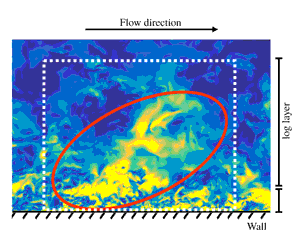Crossref Citations
This article has been cited by the following publications. This list is generated based on data provided by
Crossref.
Dong, Siwei
Huang, Yongxiang
Yuan, Xianxu
and
Lozano-Durán, Adrián
2020.
The coherent structure of the kinetic energy transfer in shear turbulence.
Journal of Fluid Mechanics,
Vol. 892,
Issue. ,
Milani, Pedro M.
Ching, David S.
Banko, Andrew J.
and
Eaton, John K.
2020.
Shear layer of inclined jets in crossflow studied with spectral proper orthogonal decomposition and spectral transfer entropy.
International Journal of Heat and Mass Transfer,
Vol. 147,
Issue. ,
p.
118972.
Lozano-Durán, Adrián
Nikolaidis, Marios-Andreas
Constantinou, Navid C.
and
Karp, Michael
2020.
Alternative physics to understand wall turbulence: Navier–Stokes equations with modified linear dynamics.
Journal of Physics: Conference Series,
Vol. 1522,
Issue. 1,
p.
012003.
Lozano-Durán, Adrián
Giometto, Marco G.
Park, George Ilhwan
and
Moin, Parviz
2020.
Non-equilibrium three-dimensional boundary layers at moderate Reynolds numbers.
Journal of Fluid Mechanics,
Vol. 883,
Issue. ,
Bae, H. Jane
Lozano-Durán, A.
and
McKeon, Beverley J.
2021.
Nonlinear mechanism of the self-sustaining process in the buffer and logarithmic layer of wall-bounded flows.
Journal of Fluid Mechanics,
Vol. 914,
Issue. ,
Guastoni, Luca
Güemes, Alejandro
Ianiro, Andrea
Discetti, Stefano
Schlatter, Philipp
Azizpour, Hossein
and
Vinuesa, Ricardo
2021.
Convolutional-network models to predict wall-bounded turbulence from wall quantities.
Journal of Fluid Mechanics,
Vol. 928,
Issue. ,
Lozano-Durán, Adrián
Constantinou, Navid C.
Nikolaidis, Marios-Andreas
and
Karp, Michael
2021.
Cause-and-effect of linear mechanisms sustaining wall turbulence.
Journal of Fluid Mechanics,
Vol. 914,
Issue. ,
Wang, Hongping
Yang, Zixuan
Wu, Ting
and
Wang, Shizhao
2021.
Coherent structures associated with interscale energy transfer in turbulent channel flows.
Physical Review Fluids,
Vol. 6,
Issue. 10,
Agostini, Lionel
and
Leschziner, Michael
2021.
Statistical analysis of outer large-scale/inner-layer interactions in channel flow subjected to oscillatory drag-reducing wall motion using a multiple-variable joint-probability-density function methodology.
Journal of Fluid Mechanics,
Vol. 923,
Issue. ,
Bae, H. Jane
and
Lee, Myoungkyu
2021.
Life cycle of streaks in the buffer layer of wall-bounded turbulence.
Physical Review Fluids,
Vol. 6,
Issue. 6,
Wang, Wenkang
Chu, Xu
Lozano-Durán, Adrián
Helmig, Rainer
and
Weigand, Bernhard
2021.
Information transfer between turbulent boundary layers and porous media.
Journal of Fluid Mechanics,
Vol. 920,
Issue. ,
Engelmann, L.
Ihme, M.
Wlokas, I.
and
Kempf, A.
2022.
Towards the Suitability of Information Entropy as an LES Quality Indicator.
Flow, Turbulence and Combustion,
Vol. 108,
Issue. 2,
p.
353.
Lozano-Durán, Adrián
and
Arranz, Gonzalo
2022.
Information-theoretic formulation of dynamical systems: Causality, modeling, and control.
Physical Review Research,
Vol. 4,
Issue. 2,
Williams, Emily
and
Lozano-Duran, Adrian
2022.
Information-Theoretic Approach for Subgrid-Scale Modeling for High-Speed Compressible Wall Turbulence.
Wang, Wenkang
Lozano-Durán, Adrián
Helmig, Rainer
and
Chu, Xu
2022.
Spatial and spectral characteristics of information flux between turbulent boundary layers and porous media.
Journal of Fluid Mechanics,
Vol. 949,
Issue. ,
Mei, Ao
Huang, Chentao
Ru, Yanyun
and
Wei, Xu
2023.
Characteristics and interactions of fluctuation velocities, saltation mass flux, and temperature in the atmospheric surface layer.
Physics of Fluids,
Vol. 35,
Issue. 12,
Encinar, Miguel P.
and
Jiménez, Javier
2023.
Identifying causally significant features in three-dimensional isotropic turbulence.
Journal of Fluid Mechanics,
Vol. 965,
Issue. ,
Tissot, Gilles
Cavalieri, André V. G.
and
Mémin, Étienne
2023.
Input-output analysis of the stochastic Navier-Stokes equations: Application to turbulent channel flow.
Physical Review Fluids,
Vol. 8,
Issue. 3,
Bai, Yuping
Yan, Peiwen
Yu, Yifei
Zhao, Quanbin
Chong, Daotong
and
Yan, Junjie
2023.
On the origin of spanwise vortex deformations during the secondary instability stage in compressible mixing layers.
Physics of Fluids,
Vol. 35,
Issue. 3,
Weigand, Bernhard
2023.
Large-eddy simulation, convective instability, and modal causality of coaxial supersonic air–water jets considering a swirl effect.
Physics of Fluids,
Vol. 35,
Issue. 6,
